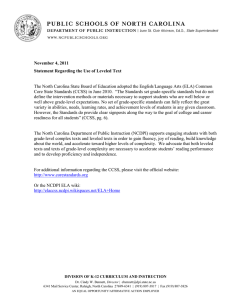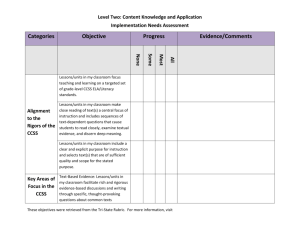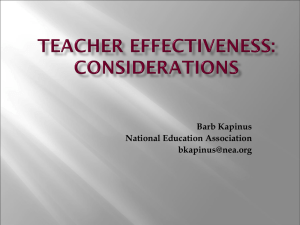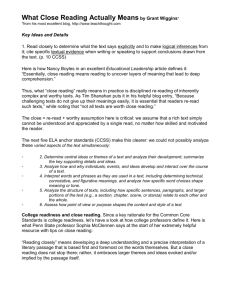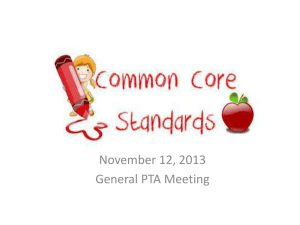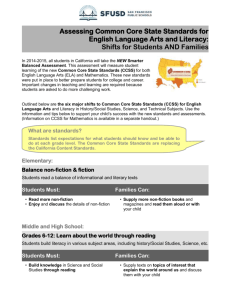COLLABORATIVE CONFERENCE FOR STUDENT ACHIEVEMENT Common Core Lesson
advertisement
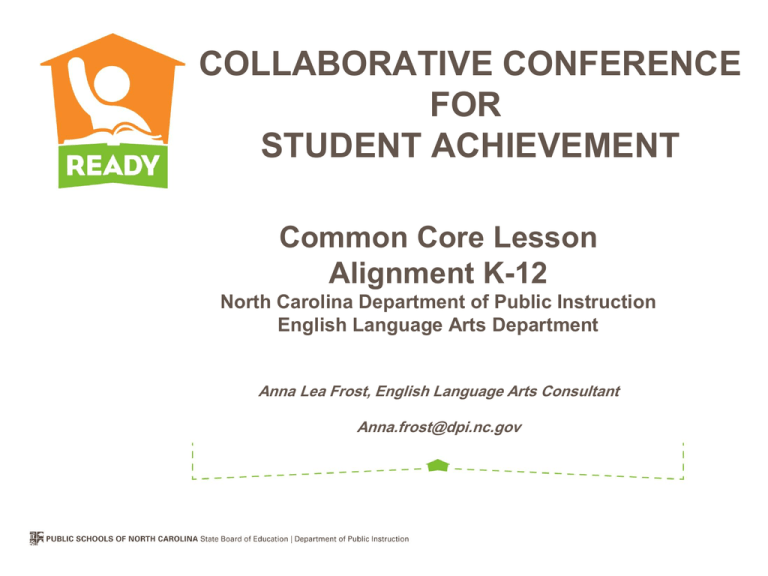
COLLABORATIVE CONFERENCE FOR STUDENT ACHIEVEMENT Common Core Lesson Alignment K-12 North Carolina Department of Public Instruction English Language Arts Department Anna Lea Frost, English Language Arts Consultant Anna.frost@dpi.nc.gov Materials Go to our Resources LiveBinder at: http://www.livebinders.com/play/pl ay/297779 Click on the tab, Quality Review Rubric Open a copy of the ELA 3-12 Quality Review Rubric Tri-State Quality Review Rubric I. Alignment to the Rigor of the CCSS The lesson/unit aligns with the letter and spirit of the CCSS: Targets a set of grade-level ELA/Literacy CCSS for teaching and learning. ** Includes a clear and explicit purpose for instruction. Selects text(s) that measure within the grade-level text complexity band and are of sufficient quality and scope for the stated purpose. (i.e., present vocabulary, syntax, text structures, levels of meaning/purpose, and other qualitative characteristics similar to CCSS grade-level exemplars in Appendices A & B) ** In addition, for units: Integrates reading, writing, speaking and listening so that students apply and synthesize advancing literacy skills. (Grades 3-5) Builds students’ content knowledge and their understanding of reading and writing in social studies, the arts, science or technical subjects through the coherent selection of texts. [Disciplinary rubrics for grades 6-12 under development.] II. Key Areas of Focus in the CCSS The lesson/unit addresses key areas of focus in the CCSS: Reading Text Closely: Makes reading text(s) closely, examining textual evidence, and discerning deep meaning a central focus of instruction. ** Text-Based Evidence: Facilitates rich and rigorous evidence-based discussions and writing about common texts through a sequence of specific, thought-provoking, and text-dependent questions (including, when applicable, illustrations, charts, diagrams, audio/video, and media). ** Writing from Sources: Routinely expects that students draw evidence from texts to produce clear and coherent writing that informs, explains, or makes an argument in various written forms (notes, summaries, short responses, or formal essays). ** Academic Vocabulary: Focuses on building students’ academic vocabulary in context throughout instruction. In addition, for units: Increasing Text Complexity: Focuses students on reading a progression of complex texts drawn from the grade-level band. Provides text-centered learning that is sequenced, scaffolded, and supported to advance students toward independent reading of complex texts at the CCR level. Balance of Texts: Includes a balance of informational and literary texts as stipulated in the CCSS [p.5] and indicated by instructional time (may be more applicable across a year). Building Disciplinary Knowledge: Provides opportunities for students to build knowledge about a topic or subject through analysis of a coherent selection of strategically sequenced, discipline-specific texts. Balance of Writing: Includes a balance of on-demand and process writing (e.g. multiple drafts/revisions over time) and short, focused research projects, incorporating digital texts where appropriate. III. Instructional Supports IV. Assessment The lesson/unit is responsive to varied student learning needs: Cultivates student interest and engagement in reading, writing, and speaking about texts. Addresses instructional expectations and is easy to understand and use. Provides all students with multiple opportunities to engage with text of appropriate complexity for the grade level; includes appropriate scaffolding so that students directly experience the complexity of the text. Focuses on challenging sections of text(s) and engages students in a productive struggle through discussion questions and other supports that build toward independence. Integrates appropriate supports for reading, writing, listening and speaking for students who are ELL, have disabilities, or read well below the grade level text band. Provides extensions and/or more advanced text for students who read well above the grade level text band. In addition, for units: Includes a progression of learning where concepts and skills advance and deepen over time. Gradually removes supports, requiring students to demonstrate their independent capacities. Provides for authentic learning, application of literacy skills, studentdirected inquiry, analysis, evaluation, and/or reflection. Integrates targeted instruction in such areas as grammar and conventions, writing strategies, discussion rules, and all aspects of foundational reading for grades 3-5. Includes independent reading based on student choice and interest to build stamina, confidence, and motivation; indicates how students are accountable for that reading. Uses technology and media to deepen learning and draw attention to evidence and texts as appropriate. The lesson/unit regularly assesses whether students are mastering standardsbased content and skills: Elicits direct, observable evidence of the degree to which a student can independently demonstrate the major targeted grade level CCSS standards with appropriately complex text(s). Assesses student proficiency using methods that are unbiased and accessible to all students. Includes aligned rubrics or assessment guidelines that provide sufficient guidance for interpreting student performance. In addition, for units: Uses varied modes of assessment, including a range of pre, formative, summative, and selfassessment measures. What is the Quality Review Rubric? 1. It is a rubric used to evaluate lessons that include instructional activities and assessments aligned to the CCSS that may extend over a few class periods or days AND to evaluate units that include integrated and focused lessons aligned to the CCSS that extend over a longer period of time. 2. The primary purpose of the Quality Review process is to provide specific input for the improvement of instructional materials so that teaching and learning are aligned with the CCSS. Note: The Tri-State Rubrics and DPI do not require a specific template for lesson or unit design. The Rubrics are not designed to evaluate a single task. Four dimensions: I. Alignment to the rigors of the CCSS II. Key areas of focus in the CCSS (the “shifts”) III. Instructional Supports IV. Assessment I. Alignment to the rigors of the CCSS The lesson/unit aligns with the letter and spirit of the CCSS: Targets a set of grade-level ELA/Literacy CCSS for teaching and learning. ** Includes a clear and explicit purpose for instruction. Selects texts that measure within the grade-level text complexity band and and are of sufficient quality and scope for the stated purpose.** (i.e., present vocabulary, syntax, text structures, levels of meaning/purpose, and other qualitative characteristics similar to CCSS grade-level exemplars in Appendices A & B) In addition, for units: Integrates reading, writing, speaking and listening so that students apply and synthesize advancing literacy skills. (Grades 3-5) Builds students’ content knowledge and their understanding of reading and writing in social studies, the arts, science or technical subjects through the coherent selection of texts. [NOTE: Disciplinary rubrics for grades 6-12 are under development.] Alignment to the Standards The Standard(s) selected are clearly evident and explicitly taught in the lesson. Make sure the entire Standard is addressed. Integration of Standards Language Reading Writing Speaking and Listening Standards from each Strand may be addressed in a lesson or unit. Text Complexity In the CCSS, text is the focus of instruction. All students should have extensive opportunities to encounter grade-level complex texts. Shorter challenging texts that elicit close reading and rereading should be a part of regular instruction. II. Key areas of focus in the CCSS The lesson/unit addresses key areas of focus in the CCSS: Reading Text Closely: Makes reading text(s) closely, examining textual evidence, and discerning deep meaning a central focus of instruction. ** Text-Based Evidence: Facilitates rich and rigorous evidence-based discussions and writing about common texts through a sequence of specific, thought-provoking, and text-dependent questions (including, when applicable, illustrations, charts, diagrams, audio/video, and media).** Writing from Sources: Routinely expects that students draw evidence from texts to produce clear and coherent writing that informs, explains, or makes an argument in various written forms (notes, summaries, short responses, or formal essays).** Academic Vocabulary: Focuses on building students’ academic vocabulary in context throughout instruction. In addition, for units: Increasing Text Complexity: Focuses students on the close reading of a progression of complex texts drawn from the grade-level band. Provides textcentered learning that is sequenced, scaffolded, and supported to advance students toward independent reading of complex texts at the CCR level. Balance of Texts: Includes a balance of informational and literary texts as stipulated in the CCSS [p.5] and indicated by instructional time (may be more applicable across a year). Building Disciplinary Knowledge: Provides opportunities for students to build knowledge about a topic or subject through analysis of a coherent selection of strategically sequenced, discipline-specific texts. Balance of Writing: Includes a balance of on-demand and process writing (e.g. multiple drafts and revisions over time) and short, focused research projects, incorporating digital texts where appropriate. Close Reading Teachers provide students with multiple opportunities to read rich texts. Text-Based Evidence Teachers facilitate learning that stays deeply connected to the text. Students develop the ability to make arguments based on evidence found in the text. Text-Dependent Questions Teachers facilitate evidence-based discussions using text-dependent questions. Text-dependent questions can serve to scaffold learning. Writing From Sources Students are asked to make a claim and use evidence from the text in their writing. Academic Vocabulary Focus vocabulary instruction on Tier 2 words in context. Balance of Informational and Literary Texts In elementary grades, the CCSS call for a balance of literary and informational texts. In ELA classes 6-12, there should be a blend of literature (fiction, poetry, and drama) and literary nonfiction III. Instructional Supports The lesson/unit is responsive to varied student learning needs: Cultivates student interest and engagement in reading, writing, and speaking about texts. Addresses instructional expectations and is easy to understand and use. Provides all students with multiple opportunities to engage with text of appropriate complexity for the grade level; includes appropriate scaffolding so that students directly experience the complexity of the text. Focuses on challenging sections of text(s) and engages students in a productive struggle through discussion questions and other supports that build toward independence. Integrates appropriate supports for students who are ELL, have disabilities, or read well below the grade level text band. Provides extensions and/or more advanced text for students who read well above the grade level text band. In addition, for units: Includes a progression of learning where concepts and/or skills advance and deepen over time. Gradually removes supports, requiring students to demonstrate their independent capacities. Provides for authentic learning, application of literacy skills, student-directed inquiry, analysis, evaluation, and/or reflection. Integrates targeted instruction in such areas as grammar and conventions, writing strategies, discussion rules, and all aspects of foundational reading for grades 3-5. Includes regular independent reading based on student choice and interest to build stamina, confidence, and motivation; indicates how students are accountable for that reading. Uses technology and media to deepen learning and draw attention to evidence and texts as appropriate. Engagement and Differentiation Lessons include instructional strategies and supports to engage ALL students in the content being studied. (ELL, EC, AIG) Expectations are clearly communicated to students. Gradual Release of Responsibility Students are provided with opportunities to engage in a “productive struggle” with challenging sections of text. Scaffolding can be provided using text-dependent questions and varied tasks. IV. Assessment The lesson/unit regularly assesses whether students are mastering standards-based content: Elicits direct, observable evidence of the degree to which a student can independently demonstrate the major targeted grade level CCSS standards with appropriately complex text(s). Assesses student proficiency using methods that are unbiased and accessible to all students. Includes aligned rubrics or assessment guidelines that provide sufficient guidance for interpreting student performance. In addition, for units: Uses varied modes of assessment, including a range of pre, formative, summative, and self-assessment measures. Use these steps to complete your rubric: 1. Record the grade and title 2. Scan the lesson 3. Identify the grade-level standards 4. Study and measure the text(s) used in the lesson 5. Analyze the lesson for evidence of the dimensions 6. Check the box for each criteria met or make suggestions for improvements Where Do I Go When My Lessons Are Not Aligned? Remember…. The purpose of the rubric is to: Align lessons and units to the CCSS Evaluate lessons and instructional resources Serve as a guide to develop new lessons Planning for Instruction 1. Read the standard - understand the expected outcomes. 2. Develop ways to explicitly model the outcomes for students. 3. Design guided practice activities where you will provide support and targeted feedback as your students develop skills and abilities to meet the outcome. 4. Develop a balance of assessments (formative and summative) for students to show you they have met the outcome. Lesson Example Grade 7: later “The Star Spangled Banner”, 200 years What did you notice? How is instruction different? What instructional components were evident in this lesson? Grade 7: “The Star Spangled Banner”, 200 years later Evidence Includes: Writing arguments Integrating Standards (Reading, Speaking and Listening, Writing) Close Reading Text-Dependent Questions / Text-Based Evidence Using the Standards as the criteria for the writing assessment Resources to Support Your Work ELA Resource LiveBinder: http://www.livebinders.com/play/play/297779 ELA Self Study LiveBinder: http://www.livebinders.com/play/play/262077 Common Core: http://www.corestandards.org/ NCDPI Common Core Support Tools: http://www.ncpublicschools.org/acre/standards/common-core-tools/ http://rt3nc.org/objects/standards/cclitmap/ela.html Resources to Support Your Work Evidence Let’s find evidence in the standards! color coding Click evidence to see where it occurs in the standards. Empowerment in implementation means knowing what to keep and what to let go. Shoulders can quickly get heavy in education. It can feel like every new idea is added to the heap of “everything to accomplish in a single day.” In order to implement the Core with success we’ll not only need to make sense of what it is, but we’ll also need to empower ourselves to determine what we let go of. Whether we decide to let go of a textbook we’ve always taught from in favor of a primary text or to keep the narrative piece of writing that sparks creativity in our students, we must remember that when our choices are purposeful we’ll find ways to intersect the Common Core Standards with the integrity of our classrooms. -Sarah Wessling's Top Ten Common Core Insider Secrets Q&A Contact Information: Julie Joslin, Ed.D. Section Lead English Language Arts 919-807-3935 Julie.Joslin@dpi.nc.gov Anna Lea Frost, M.Ed. 6-8 English Language Arts Consultant 919-807-3952 Anna.Frost@dpi.nc.gov Lisa McIntosh, MSA K-5 English Language Arts Consultant 919-807-3895 Lisa.Llewellyn@dpi.nc.gov Alex Kaulfuss, Ph.D. Grades 9-12 English Language Arts 919-807-3833 Alex.Kaulfuss@dpi.nc.gov ELA Common Core State Standards Self Study LiveBinder: http://www.livebinders.com/play/play/262077 Have you Seen… ELA Resources LiveBinder: http://www.livebinders.com/play/play/297779 COLLABORATIVE CONFERENCE FOR STUDENT ACHIEVEMENT Common Core Lesson Alignment K-12 North Carolina Department of Public Instruction English Language Arts Department Anna Lea Frost, English Language Arts Consultant Anna.frost@dpi.nc.gov
